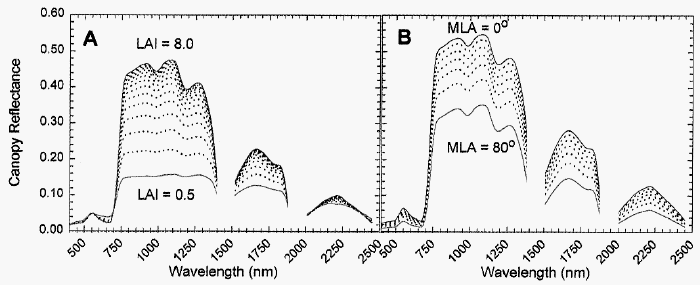Leaf reflectance properties, controlled by properties of pigments, water, and carbon, play a significant role in reflectance at the canopy level. Additionally, the amount of foliage and the architecture of the canopy are also meaningful in determining the scattering and absorption properties of vegetation canopies. Different ecosystems, whether they be forest, grassland, or agricultural field, have different reflectance properties, even though the properties of individual leaves are usually quite similar. Vegetation with mostly vertical foliage, such as grass, reflects light differently than foliage with more horizontally-oriented foliage, seen frequently in trees and tropical forest plants. The variation in reflectance caused by different canopy structures, much like individual leaf reflectance, is highly variable with wavelength.
There are a variety of vegetation properties of interest to scientists at the canopy level, and many of these have direct effects on canopy reflectance properties. The two most significant are leaf area index (LAI) and leaf angle distribution (LAD). The LAI is the green leaf area per unit ground area, which represents the total amount of green vegetation present in the canopy. The LAI is an important property of vegetation, and has the strongest effect on overall canopy reflectance. The LAD describes the overall variety of directions in which the leaves are oriented, but is often simplified by specifying the mean leaf angle (MLA) and making assumptions about the actual distribution. The MLA is the average of the differences between the angle of each leaf in a canopy and horizontal.
The following figures show the effects of LAI and LAD on reflectance of radiation by vegetation canopies. In this plot, MLA is the parameter that represents LAD.

Whereas vegetation strongly reflects light in the near-infrared portion of the spectrum, canopies strongly absorb photons in the visible and SWIR-2 ranges. This results in a much shallower penetration of photons into the canopy in these wavelengths. As such, VIs using spectral data from the visible and SWIR-2 are very sensitive to upper-canopy conditions. In contrast, photons are scattered in the near-infrared and SWIR‑1 range. Therefore, these photons measured by a remote sensing instrument come from reflections throughout much of a vegetation canopy.
See Also
Vegetation Indices, Vegetation Analysis Tools, Vegetation and Its Reflectance Properties